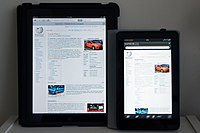
Photo from wikipedia
OBJECTIVE Examine whether distribution of tablets to patients with access barriers influences their adoption and use of patient portals. MATERIALS AND METHODS This retrospective cohort study included Veterans Affairs (VA)… Click to show full abstract
OBJECTIVE Examine whether distribution of tablets to patients with access barriers influences their adoption and use of patient portals. MATERIALS AND METHODS This retrospective cohort study included Veterans Affairs (VA) patients (n = 28 659) who received a VA-issued tablet between November 1, 2020 and April 30, 2021. Tablets included an app for VA's My HealtheVet (MHV) portal. Veterans were grouped into 3 MHV baseline user types (non-users, inactive users, and active users) based on MHV registration status and feature use pre-tablet receipt. Three multivariable models were estimated to examine the factors predicting (1) MHV registration among non-users, (2) any MHV feature use among inactive users, and (3) more MHV use among active users post-tablet receipt. Differences in feature use during the 6 months pre-/post-tablet were examined with McNemar chi-squared tests of proportions. RESULTS In the 6 months post-tablet, 1298 (8%) non-users registered for MHV, 525 (24%) inactive users used at least one MHV feature, and 4234 (46%) active users increased feature use. Across veteran characteristics, there were differences in registration and feature use post-tablet, particularly among older adults and those without prior use of video visits (P < .01). Among active users, use of all features increased during the 6 months post-tablet, with the greatest differences in viewing prescription refills and scheduling appointments (P < .01). CONCLUSION Providing patients who experience barriers to in-person care with a portal-enabled device supports engagement in health information and management tasks. Additional strategies are needed to promote registration and digital inclusion among inactive and non-users of portals.
Journal Title: Journal of the American Medical Informatics Association : JAMIA
Year Published: 2022
Link to full text (if available)
Share on Social Media: Sign Up to like & get
recommendations!